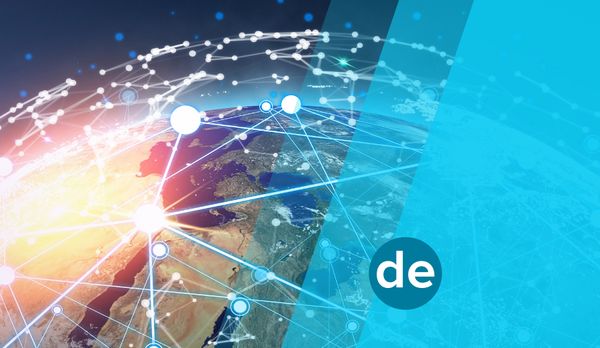Organizations that perform central tasks – even on a global level – usually seem unapproachable, intransparent and out of touch from the reality of their personal lives to the majority of people. Why they should look at ICANN differently.
The institutions that act as the "control centers" behind the administration of the Internet are scarcely in the public eye – because as long as things run as they should, as long as e-mails arrive, news portals and web stores, the digital bank account and social media can be accessed and used, very few people are normally interested in who is making sure that the Internet's "telephone book" – the Domain Name System – works in the background in a secure, stable and reliable way. This also applies to the Internet Corporation for Assigned Names and Numbers, or ICANN for short, although the organization is the linchpin of a functioning Internet.
At the end of September, it was exactly 25 years ago that ICANN took on the central role of ensuring that the basic technical resources of the Internet are coordinated at the global level: the "names" that are easy for people to remember and the "numbers" that computers use to recognize each other. It is only by linking the two with each other – referred to as "name resolution" – that navigating the Internet is possible by all connected people worldwide, using it as an information and communication medium, even if the underlying structures and systems are a closed book to them.
At the same time, thanks to a very special form of organization, ICANN is even more: an epitome of the independent management of the Internet by the international community. In other words, something that was long taken for granted, but today – in times of increasing global differences – is not so obvious anymore.
What may initially sound very abstract and technical – and thus not very comprehensible – becomes clear when you take a look behind the scenes.
Why an Organization like ICANN is Needed: Tasks of Global Internet Management
A good ten years ago, ICANN was mentioned here and there across public media with a broader, non-specialized target audience: more specifically, when it came to introducing additional extensions for Internet domains – the so-called new generic Top-Level Domains (new gTLDs) – starting in 2012. The application process and subsequent deployment resulted in more than a thousand new domain extensions, which since 2014 have gradually expanded the name space on the Internet – everything "to the right of the dot" – beyond the familiar, classical TLDs such as .de or .com: from .berlin and .bayern to .hotel and .insurance, .online or so-called "brand TLDs", i. e. domain extensions identical to company or product brands. Not forgetting the IDN TLDs, which were also introduced at that time: internationalized domain names that now allow millions of Internet users for the first time to utilize in the Internet's addressing service, the Domain Name System (DNS), their own non-Latin characters and alphabets, common for example in Eastern and Southeastern European regions, or the Arabic and AsiaPacific world. And it is now certain that even more TLDs are about to be released from 2026.
Allright, but where is ICANN’s role in all this? Well, anyone who goes to a website on the Internet or writes an e-mail, regardless of the respective address, relies more or less blindly on their browser displaying the desired information or their mail program delivering the message to the correct recipient. However, in order for the services and technical systems linked in the large Internet network to be able to communicate with each other without errors, fixed agreements and rules are required. Or, in other words, universally valid designation conventions that are interpreted and understood in the same way by all components of the system – and thus ensure that these are interoperable. This is where the "unique identifiers," the "names" and "numbers" at the level of Top-Level Domains and IP address ranges, protocol parameters and larger network clusters ("autonomous systems," AS) come into play. Together, through their interconnection, they form the technical Internet – and enable mutual communication of all computers and devices connected to the Internet via the service that „translates“ domains into IP numbers: the Domain Name System (DNS).
At the same time, there is a need for an organization that coordinates the DNS: one that holds the threads together and in this way reliably ensures that only unique numerical Internet addresses and domain extensions are used worldwide – without ever resulting in the assignment of two identical addresses. This is precisely where ICANN intervenes: on the one hand, by allocating Top-Level Domains to central registries (TLD Registries) such as DENIC for .de, which then manage the registration of domains in the relevant namespaces and carry out the resolution of domains into IP numbers within the namespace they operate. On the other hand, by assigning IP address blocks to five "Regional Internet Registries" (RIRs), which in turn allocate smaller portions of them to "Local Internet Registries" such as access providers or web hosts in a given geographical area.
To ensure that name resolution on the Internet, i. e. the translation of user-friendly "names" (domains) into technical "numbers" (Internet Protocol addresses), can function at all at the root of the Domain Name System, so-called root servers are in operation worldwide, in which the names and IP numbers of the name servers of all Top-Level Domains (TLDs) are stored. Overall, this "root zone" currently comprises around 1,600 generic and country-specific TLDs. ICANN also coordinates the smooth operation of the root server system and, in addition, runs one of these servers itself.
Moreover, the administration and regular exchange of the root zone's cryptographic master key (Key Signing Key) is also in ICANN's hands. This master key, forming part of security enhancements to the Domain Name System called DNSSEC, secures the DNS and protects it against manipulation.
Last but not least, and no less important, serves ICANN as a platform for the Internet community to develop those rules within its structures that are necessary for the smooth interaction of all aforementioned technical functions – and thus to maintain and improve the operational stability, reliability, security and global interoperability of the Internet. In short, if ICANN did not exist, the Internet would not function.
However, and important to know: The tasks of technical network management – performed by organizations such as ICANN, but also by all infrastructure operators such as Regional Internet Registries and TLD Registries – explicitly do not include dealing with content offered under domains.
A Prime Example of the Multistakeholder Model: How ICANN is Organized
As an organization whose mission is to globally coordinate the management and creation of rules for the Internet, ICANN is responsible for the very key resource of the 21st century. Truly notable in this context is its structure, unprecedented for an organization serving to address globally important issues – for ICANN is neither an intergovernmental organization nor a traditional non-governmental organization.
What is new and so far unique about an organization with a global focus like ICANN is that it brings together different types of stakeholders from all over the world according to a participation approach in which all stakeholders involved act and exchange views on an equal footing – meaning, for example, that governments do not per se have a stronger standing than contributions from the civil society. This "model of the many" makes ICANN a prototype of what is known to be the multistakeholder principle.
But let us start from the beginning: According to its Bylaws, ICANN is a non-profit public benefit corporation under California law, whose work is no longer under state control. Yet, this was not always the case: After its foundation in 1998, ICANN was initially dependent on the Telecommunications Authority (NTIA) of the U.S. Department of Commerce, which acted both as a contractual partner and supervisory authority for the organisation. Historically, this was rooted in the origins of the Internet, which had been in networks of the American military and scientific research institutions since the 1960s (ARPANET/Advanced Research Projects Agency Network). It was not until the Internet was increasingly used privately and commercially in the 1990s that the NTIA decided to detach from the informal academic realms the management and allocation of Internet addresses and protocol parameters, which are important for ist interoperability, and transfer these tasks to an independent organization: This was when ICANN was launched.
A milestone in the history of Internet address management then loomed in September 2016: As part of an orderly transition process known as the IANA Stewardship Transition, ICANN became independent of the U.S. government and reconstituted itself as a multistakeholder organization with an empowered community. Since then, the Internet's core technical functions, i. e. the DNS root zone and the system of unique identifiers (names and numbers), have for the first time been operated and controlled independently and in their own right by the global Internet community, represented by ICANN.
The reform package focused on the functional separation of ICANN's coordinating tasks from the so-called "IANA functions," which comprise the management of the root zone and the central databases for IP addresses, protocol numbers, and administrative data of the more than 1,000 Top-Level Domains, which are key to the global functioning of the Internet. These IANA functions, indeed very technical in nature, are highly symbolic in terms of the self-governance model. By enshrining measures that safeguard the permanent preservation of the open, stable, and secure Internet independent of intergovernmental organizations such as the United Nations or the International Telecommunication Union (ITU), the consensus proposal developed in intensive multistakeholder negotiations fulfilled the conditions attached to the removal of IANA functions from U.S. government oversight effective October 2016. Since then, responsibility for the IANA functions has rested with a newly established organization that is still affiliated with ICANN, but legally independent: the PTI (Public Technical Identifiers).
No Chance for "Elites" Meeting behind Closed Doors: How ICANN Works
As the Internet is now used by more than two-thirds of the world's population, it makes sense to involve the broader Internet community, i. e. all stakeholder groups representing different interests, when it comes to defining "rules of the game" that affect the current and future use of the ever-changing Internet landscape. Therefore, ICANN has a number of sub-groups and constituencies in which these stakeholders can gather and exchange ideas in order to collectively formulate and contribute their positions to the ICANN ecosystem. In doing so, ICANN explicitly seeks broad, informed participation at all levels of policy development and decision-making, reflecting the functional, geographic, and cultural diversity of the Internet, and thus including voices from all stakeholder groups and world regions (North America, South America, Europe, Africa, AsiaPacific) in ICANN forums and committees.
Stakeholder groups include governments, end-users, and the various technical stakeholders. They are represented within ICANN through four Advisory Committees (ACs): the Governmental Advisory Committee (GAC), the At-Large Advisory Committee (ALAC), the Root Server System Advisory Committee (RSSAC), and the Security and Stability Advisory Committee (SSAC). Individual issues concerning the management of domain names and IP numbers are also addressed by three Supporting Organizations (SOs): the ccNSO – of which DENIC is also a member – for the management of country-code Top-Level Domains (ccTLDs), the GNSO for the management of generic Top-Level Domains (gTLDs) and the ASO (Address Supporting Organization) for the management of IP addresses. All stakeholder groups contribute to the final decisions that ICANN makes.
ICANN is governed by a globally diverse 16-member Board of Directors, which elects a Chair from among its midst. Some of the directors are seconded by the "Supporting Organizations" (SOs), and some by a Nominating Committee (NomCom) whose members are drawn on a rolling basis from the various stakeholder and regional groups. Governments as well as other Advisory Committees (ACs) are represented by liaisons.
Important to know: Binding rulemaking by ICANN applies exclusively to registries and registrars of generic TLDs. With these, ICANN has concluded direct contracts. In contrast, ccTLD registries such as DENIC, which manage and operate country-code TLDs, are not subject to the ICANN regime and are free in their policy-making to the extent that they exclusively serve and are obligated to their respective local community. Therefore, agreements exist between ICANN and such registries that recognize the importance of the respective other organization in the DNS ecosystem.
Sometimes Tedious and Lengthy, but Always Consensus-Based: Decision-making at ICANN
An important asset of a multi-stakeholder organization like ICANN is also its transparency, that is the ability to understand why fundamental decisions are made, how they are made, and on what basis those decisions are taken.
The ICANN Bylaws clearly state that all fundamental decisions are to be made based on open dialogue and a consensus-driven approach. Open and transparent policy development mechanisms are used that promote well-informed decisions based on expert advice and ensure that the most affected organizations can participate in the policy development process. Decisions are made through the neutral and objective application of documented guidelines based on integrity and fairness.
A typical ICANN decision-making process is that issues or proposed changes are raised within one of the Supporting Organizations and summarized in a report that is then made available for public review. If the proposed changes affect another of ICANN's sub-groups, that sub-group reviews the proposal and again shares its views. The result is then presented to the public again.
At the end of this process, a report is provided to the ICANN Board with all previous discussions and a list of recommendations. The Board discusses the matter, approves the changes, rejects them (in part), or sends the matter back to one of the Supporting Organizations for consideration so that any issues preventing approval can be resolved. Then the process is gone through again, and either a compromise is negotiated between the ICANN sub-groups involved, or a decision is made by the Board based on a submitted report. This is "bottom-up" in its purest sense.
Lobby Funding? No Way!: Where the Money for ICANN Comes From
Funding is another key criteria for an organization's independence, especially if it is thoroughly committed to the multistakeholder principle, as ICANN is. If money flows from individual stakeholders with the aim of influencing decisions in their favor, this would run counter to the idea of transparent, equal participation of all stakeholders. For this reason, ICANN is financed exclusively from the technical community, and more specifically by means of the proportionate dues as well as the voluntary contributions made by the registry operators of the generic and country-code Top-Level Domains (gTLDs, ccTLDs), respectively, and the five Regional Internet Registries (RIRs), which allocate IP addresses to the various geographical regions. The remaining ICANN budget comes from the registrars of gTLD domains, who must obtain ICANN accreditation, follow the terms and conditions set by the organization, and pay a tax for each registered generic domain. And finally, there is revenue from the fee-based application process for new generic Top-Level Domains.
Virtual and Face-to-Face: How the ICANN Community Works Together
To bring the international community involved in ICANN's participation processes together, much of the work takes place year-round through regular virtual exchanges. Three times a year, however, the ICANN community meets in person at public meetings in various locations around the world to further advance or, at best, finalize the issues negotiated in the individual working groups.
The next of these meetings, which is co-organized by DENIC, will take place in Hamburg, Germany from 21 to 26 October 2023. In the light of current developments, the event’s special focus will be on the approval processes for further Top-Level Domains, but also on topics such as digital inclusion, data protection and the future of the Internet’s independent management.















